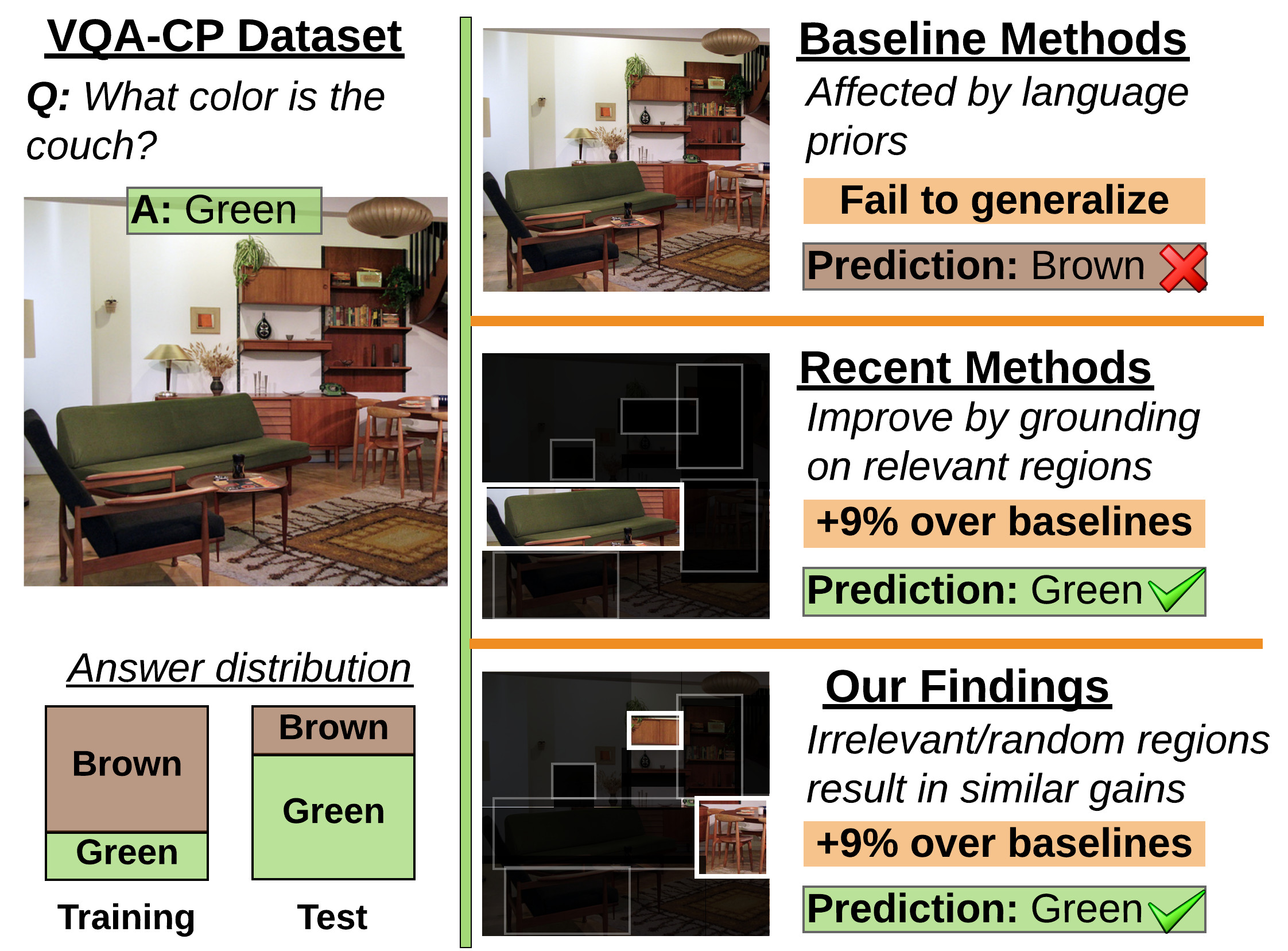A negative case analysis of visual grounding methods for VQA (ACL 2020 short paper)
Recent works in VQA attempt to improve visual grounding by training the model to attend to query-relevant visual regions. Such methods have claimed impressive gains in challenging datasets such as VQA-CP. However, in this work we show that boosts in performance come from a regularization effect as opposed to proper visual grounding.
This repo is based on Self-Critical Reasoning codebase.
Install dependencies
We use Anaconda to manage our dependencies. You will need to execute the following steps to install all dependencies:
-
Edit the value for
prefixvariable inrequirements.ymlfile, by assigning it the path to conda environment -
Then, install all dependencies using:
conda env create -f requirements.yml -
Change to the new environment:
source activate negative_analysis_of_grounding -
Install:
python -m spacy download en_core_web_lg
Executing scripts
While executing scripts, first ensure that your main project directory is in PYTHONPATH:
cd ${PROJ_DIR} && export PYTHONPATH=.
Setting up data
- Inside
scripts/common.sh, editDATA_DIRvariable by assigning it the path where you wish to download all data - Download UpDn features from google drive into
${DATA_DIR}folder - Download questions/answers for VQAv2 and VQA-CPv2 by executing
./scripts/download.sh - Preprocess VQA datasets by executing:
./scripts/preprocess.sh - Download
ans_cossim.pkland place it into${DATA_DIR}
Training baseline model
We are providing pre-trained models for both VQAv2 and VQA-CPv2 here
To train the baselines yourself execute ./scripts/baseline/vqacp2_baseline.sh.
- Note#1: We need pre-trained baseline model to train HINT/SCR and our regularizer.
- Note#2: We need to train baselines on 100% of the training set. However, by default, the training script expects to train only on subset with visual hints (e.g., HAT or textual explanations).
So, to train baseline, we need to use the flag
--do_not_discard_items_without_hints, otherwise it will throw an error message saying thathint_typeflag is missing.
Training state-of-the-art models
Setting up data
- Download visual cues/hints from https://drive.google.com/drive/folders/1fkydOF-_LRpXK1ecgst5XujhyQdE6It7?usp=sharing into the following directory:
${DATA_DIR}/hints- The shared folder contains Human Attention Map-based cues and Textual Explanations-based cues
- The folder contains 3 versions for each type of cue: a) relevant cues (original) b) irrelevant cues (1 - relevant) c) random cues
The following scripts train HINT/SCR with a) relevant cues b) irrelevant cues c) fixed random cues and d) varying random cues:
Training HINT [1]
Execute ./scripts/hint/vqacp2_hint.sh for VQACPv2
Execute ./scripts/hint/vqa2_hint.sh for VQAv2
Training SCR [2]
Execute ./scripts/scr/vqacp2_scr.sh for VQACPv2
Execute ./scripts/scr/vqa2_scr.sh for VQAv2
Note: By default, HINT and SCR are only trained on subset with visual cues. To train on full dataset, please specify --do_not_discard_items_without_hints flag.
Training our 'zero-out' regularizer
- Execute
./scripts/our_zero_out_regularizer/vqacp2_zero_out_full.shto train with our regularizer on 100% of VQACPv2 - Execute
./scripts/our_zero_out_regularizer/vqacp2_zero_out_subset.shto train with our regularizer on a subset of VQACPv2 - Execute
./scripts/our_zero_out_regularizer/vqa2_zero_out_full.shto train with our regularizer on 100% of VQAv2 - Execute
./scripts/our_zero_out_regularizer/vqa2_zero_out_subset.shto train with our regularizer on a subset of VQAv2
Analysis
Computing rank correlation
Please refer to scripts/analysis/compute_rank_correlation.sh for sample scripts that can be used to compute rank correlations.
The script uses the object sensitivity files generated during the training/evaluation.
References
[1] Selvaraju, Ramprasaath R., et al. "Taking a hint: Leveraging explanations to make vision and language models more grounded." Proceedings of the IEEE International Conference on Computer Vision. 2019.
[2] Wu, Jialin, and Raymond Mooney. "Self-Critical Reasoning for Robust Visual Question Answering." Advances in Neural Information Processing Systems. 2019.
